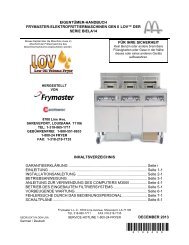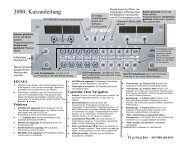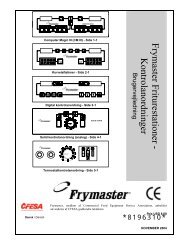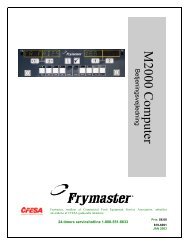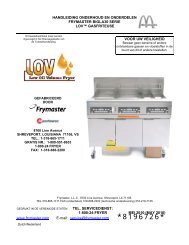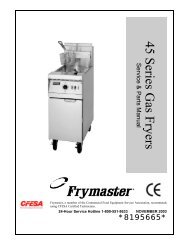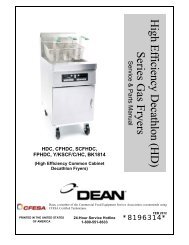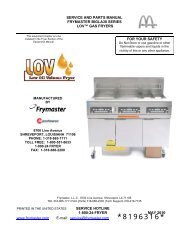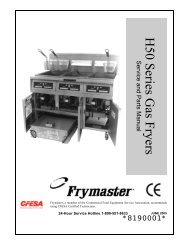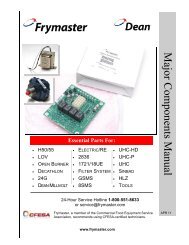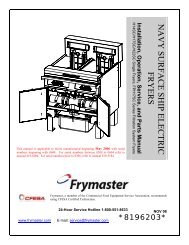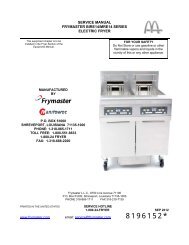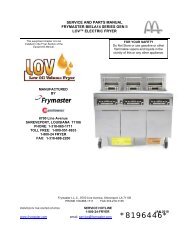GF14 and GF40 Series Gas Fryers - Frymaster
GF14 and GF40 Series Gas Fryers - Frymaster
GF14 and GF40 Series Gas Fryers - Frymaster
Create successful ePaper yourself
Turn your PDF publications into a flip-book with our unique Google optimized e-Paper software.
January 2008 <strong>and</strong> Later Models<br />
Use 819-5888 for earlier units<br />
<strong>GF14</strong> <strong>and</strong> <strong>GF40</strong> <strong>Series</strong> <strong>Gas</strong><br />
<strong>Fryers</strong><br />
Service & Parts Manual<br />
<strong>Frymaster</strong>, a member of the Commercial Food Equipment Service Association, recommends<br />
using CFESA Certified Technicians.<br />
24-Hour Service Hotline 1-800-551-8633 SEPT 2008<br />
*8196438*
NOTICE<br />
This appliance is intended for professional use only <strong>and</strong> is to be operated by qualified<br />
personnel only. A <strong>Frymaster</strong>/DEAN Factory Authorized Service Center (FASC) or other qualified<br />
professional should perform installation, maintenance, <strong>and</strong> repairs. Installation, maintenance,<br />
or repairs by unqualified personnel may void the manufacturer’s warranty. See Chapter 1 of<br />
this manual for definitions of qualified personnel.<br />
NOTICE<br />
This equipment must be installed in accordance with the appropriate national <strong>and</strong> local codes of<br />
the country <strong>and</strong>/or region in which the appliance is installed. See NATIONAL CODE<br />
REQUIREMENTS in Chapter 2 of this manual for specifics.<br />
NOTICE TO U.S. CUSTOMERS<br />
This equipment is to be installed in compliance with the basic plumbing code of the Building<br />
Officials <strong>and</strong> Code Administrators International, Inc. (BOCA) <strong>and</strong> the Food Service Sanitation<br />
Manual of the U.S. Food <strong>and</strong> Drug Administration.<br />
NOTICE<br />
Drawings <strong>and</strong> photos used in this manual are intended to illustrate operational, cleaning <strong>and</strong><br />
technical procedures <strong>and</strong> may not conform to onsite management operational procedures.<br />
NOTICE TO OWNERS OF UNITS EQUIPPED WITH COMPUTERS<br />
U.S.<br />
This device complies with Part 15 of the FCC rules. Operation is subject to the following two<br />
conditions: 1) This device may not cause harmful interference, <strong>and</strong> 2) This device must accept<br />
any interference received, including interference that may cause undesired operation. While<br />
this device is a verified Class A device, it has been shown to meet the Class B limits.<br />
CANADA<br />
This digital apparatus does not exceed the Class A or B limits for radio noise emissions as set<br />
out by the ICES-003 st<strong>and</strong>ard of the Canadian Department of Communications.<br />
Cet appareil numerique n’emet pas de bruits radioelectriques depassany les limites de classe A<br />
et B prescrites dans la norme NMB-003 edictee par le Ministre des Communcations du Canada.<br />
DANGER<br />
Improper installation, adjustment, maintenance or service, <strong>and</strong> unauthorized alterations or<br />
modifications can cause property damage, injury, or death. Read the installation, operating,<br />
<strong>and</strong> service instructions thoroughly before installing or servicing this equipment. Only qualified<br />
service personnel may convert this appliance to use a gas other than that for which it was<br />
originally configured.<br />
DANGER<br />
No structural material on the fryer should be altered or removed to accommodate placement of<br />
the fryer under a hood. Questions? Call the <strong>Frymaster</strong>/Dean Service Hotline at 1-800-551-8633.
DANGER<br />
Adequate means must be provided to limit the movement of this appliance without depending<br />
upon the gas line connection. Single fryers equipped with legs must be stabilized by installing<br />
anchor straps. All fryers equipped with casters must be stabilized by installing restraining<br />
chains. If a flexible gas line is used, an additional restraining cable must be connected at all<br />
times when the fryer is in use.<br />
DANGER<br />
The front ledge of the fryer is not a step! Do not st<strong>and</strong> on the fryer. Serious injury can result<br />
from slips or contact with the hot oil.<br />
DANGER<br />
Do not store or use gasoline or other flammable liquids or vapors in the vicinity of this or any<br />
other appliance.<br />
DANGER<br />
Instructions to be followed in the event the operator smells gas or otherwise detects a gas leak<br />
must be posted in a prominent location. This information can be obtained from the local gas<br />
company or gas supplier.<br />
DANGER<br />
This product contains chemicals known to the state of California to cause cancer <strong>and</strong>/or birth<br />
defects or other reproductive harm.<br />
Operation, installation, <strong>and</strong> servicing of this product could expose you to airborne particles of<br />
glasswool or ceramic fibers, crystalline silica, <strong>and</strong>/or carbon monoxide. Inhalation of airborne<br />
particles of glasswool or ceramic fibers is known to the State of California to cause cancer.<br />
Inhalation of carbon monoxide is known to the State of California to cause birth defects or other<br />
reproductive harm.
<strong>GF14</strong> <strong>and</strong> <strong>GF40</strong> SERIES GAS FRYERS<br />
TABLE OF CONTENTS<br />
CHAPTER 1: Service Procedures<br />
1.1 Functional Description......................................................................................... 1-1<br />
1.2 Accessing <strong>Fryers</strong> for Servicing............................................................................ 1-2<br />
1.3 Cleaning the <strong>Gas</strong> Valve Vent Tube ..................................................................... 1-2<br />
1.4 Checking the Burner Manifold Pressure.............................................................. 1-2<br />
1.5 Adjusting Deflector Spacing <strong>and</strong> Alignment....................................................... 1-2<br />
1.6 Adjusting the Pilot Flame .................................................................................... 1-3<br />
1.7 Replacing Fryer Components .............................................................................. 1-3<br />
1.7.1 Replacing the Operating Thermostat ................................................................... 1-3<br />
1.7.2 Replacing the High-Limit Thermostat................................................................. 1-4<br />
1.7.3 Replacing Deflectors............................................................................................ 1-5<br />
1.7.4 Replacing the <strong>Gas</strong> Valve...................................................................................... 1-6<br />
1.7.5 Replacing the Thermopile or Pilot Assembly...................................................... 1-7<br />
1.7.6 Replacing the Frypot............................................................................................ 1-8<br />
1.8 Troubleshooting <strong>and</strong> Problem Isolation............................................................... 1-9<br />
1.8.1 Pilot Failure.........................................................................................................1.10<br />
1.8.2 Improper Burner Functioning ............................................................................ 1-11<br />
1.8.3 Improper Temperature Control...........................................................................1.11<br />
1.8.4 Leaking ...............................................................................................................1.11<br />
1.9 Wiring Diagrams................................................................................................ 1-12<br />
1.9.1 Current Production Units with Honeywell <strong>Gas</strong> Valve....................................... 1-12<br />
CHAPTER 2: Parts Lists<br />
Accessories ...................................................................................................................... 2-1<br />
Burner <strong>and</strong> <strong>Gas</strong> Supply Components............................................................................... 2-2<br />
Cabinetry Components..................................................................................................... 2-4<br />
Frypot <strong>and</strong> Related Components...................................................................................... 2-5<br />
i
1.1 Functional Description<br />
<strong>GF14</strong>/<strong>GF40</strong> SERIES GAS FRYERS<br />
CHAPTER 1: SERVICE PROCEDURES<br />
The <strong>GF14</strong> <strong>and</strong> <strong>GF40</strong> <strong>Series</strong> fryers contain a welded steel (stainless or cold-rolled) frypot that is<br />
heated by gas flames diffused over its lower surface by deflectors. In both units, the deflectors are<br />
made of stainless. The rear deflector on the <strong>GF14</strong> is attached to the flue. The <strong>GF40</strong>’s rear deflector is<br />
attached to the burner manifold.<br />
Both the <strong>GF14</strong> <strong>and</strong> the <strong>GF40</strong> burners have metal<br />
targets. The <strong>GF40</strong> has two orifices per target.<br />
The flames originate from orifices in a U-shaped burner manifold positioned beneath the frypot.<br />
The orifice diameters differ for natural <strong>and</strong> Propane (LP) gas <strong>and</strong> for fryers as indicated in the<br />
accompanying table (NOTE: This table shows only the orifices used in elevations up to 1999<br />
feet/609 meters. <strong>GF14</strong> fryers have one orifice per deflector; <strong>GF40</strong> fryers have two orifices per<br />
deflector assembly.<br />
<strong>GF14</strong>/<strong>GF40</strong> <strong>Series</strong> Orifice Sizes (0-1999 ft/609 m)<br />
Fryer & <strong>Gas</strong> Type Inches Millimeters<br />
<strong>GF14</strong> Natural 0.065 1.65mm<br />
<strong>GF14</strong> Propane (LP) 0.041 1.05mm<br />
<strong>GF40</strong> Natural 0.057 1.45mm<br />
<strong>GF40</strong> Propane (LP) 0.034 0.86mm<br />
An electromechanical millivolt gas valve regulates gas flow to the burner manifold. <strong>GF14</strong>/<strong>GF40</strong><br />
fryers use a pilot ignition system to control burner firing.<br />
Pilot Ignition System<br />
The pilot ignition system is made up of the pilot orifice, pilot hood, <strong>and</strong> a thermopile. The pilot<br />
serves two purposes: lighting the burner <strong>and</strong> heating the thermopile. In operation, the thermopile is<br />
in contact with the pilot flame <strong>and</strong> generates millivolts. The millivolt output passes through a<br />
normally closed high-limit switch <strong>and</strong> energizes the gas valve pilot coil, which in turn opens the<br />
pilot valve. If the pilot flame is extinguished, voltage is lost to the gas valve pilot coil <strong>and</strong> the pilot<br />
valve closes.<br />
1-1<br />
The rear target is attached to the manifold on the<br />
<strong>GF40</strong>. It is attached to the cabinet in the <strong>GF14</strong>.
Thermostats<br />
1. These fryers are equipped with adjustable operating thermostats. The temperature at which the<br />
thermostat opens <strong>and</strong> closes is adjusted by rotating a knob. The tolerance b<strong>and</strong> of the Sunne<br />
thermostat is +10°F (+6°C) <strong>and</strong> -20°F (-11°C ).<br />
<strong>Fryers</strong> in the <strong>GF14</strong>/<strong>GF40</strong> series are also equipped with a high-limit thermostat. In the event that the<br />
fryer fails to properly control the oil temperature, the high-limit thermostat prevents the fryer from<br />
overheating to the flash point. The high-limit thermostat acts as a normally closed power switch that<br />
opens when exposed to temperatures above 425ºF to 450ºF (218ºC to 232ºC).<br />
1.2 Accessing <strong>Fryers</strong> for Servicing<br />
DANGER<br />
Moving a fryer filled with cooking oil/shortening may cause spilling or splattering of<br />
the hot liquid. Follow the draining instructions in Chapter 3 of the Installation <strong>and</strong><br />
Operation manual before attempting to relocate a fryer for servicing.<br />
1. Drain all cooking oil/shortening from the fryer.<br />
2. Shut off the gas supply to the unit <strong>and</strong> disconnect the unit from the gas supply.<br />
3. Remove any attached restraining devices.<br />
4. Relocate the fryer for service accessibility.<br />
5. After servicing is complete, reconnect the unit to the gas supply <strong>and</strong> reattach the restraining<br />
devices.<br />
6. Refill the frypot with cooking oil/shortening.<br />
1.3 Cleaning the <strong>Gas</strong> Valve Vent Tube<br />
Refer to Quarterly Checks <strong>and</strong> Services in Chapter 4 of the Installation <strong>and</strong> Operation manual.<br />
1.4 Checking the Burner Manifold Pressure<br />
See step 7-15 in section 1.7.4, Replacing the <strong>Gas</strong> Valve.<br />
1.5 Adjusting Deflector Spacing <strong>and</strong> Alignment<br />
DANGER<br />
Drain the frypot or remove the h<strong>and</strong>le from the drain valve before proceeding further.<br />
Proper spacing of the edge of the deflectors is ¾-inch (19mm) from the frypot side. To adjust target<br />
spacing, bend the brackets to which they are attached away or toward the frypot to the proper<br />
distance. (A board of the proper thickness is useful as a gauge to verify spacing <strong>and</strong> alignment.)<br />
The illustration below depicts a typical <strong>GF40</strong>. The <strong>GF14</strong> procedure is the same except that there are<br />
no ceramic targets.<br />
1-2
1.6 Adjusting the Pilot Flame<br />
1. Remove the cap shown in the illustration below to access the pilot flame adjustment screw in the<br />
gas valve.<br />
1-3<br />
Remove this cap to<br />
access the pilot flame<br />
adjustment screw.<br />
2. Using a small, flat-tipped screwdriver, turn the pilot flame adjustment screw counterclockwise to<br />
increase the length of the flame or clockwise to decrease the length of the flame. Adjust the<br />
flame to a length of 1 to 1½ inches (25 to 38 mm).<br />
3. Reinstall the pilot flame adjustment screw cap.<br />
1.7 Replacing Fryer Components<br />
1.7.1 Replacing the Operating Thermostat<br />
1. Drain the fryer <strong>and</strong> turn the gas off.<br />
2. Remove the thermostat knob by pulling straight out on the knob with a firm, steady pull.<br />
3. Disconnect the wires from the thermostat.<br />
4. Remove the two mounting screws to release the thermostat control from its mounting bracket.
5. Straighten the clips that secure the thermostat bulb to the frypot. Use a slotted socket to unscrew<br />
the thermostat from the frypot.<br />
6. Loosen the capillary tube compression nut (the small nut) on the replacement thermostat so that<br />
it slides freely on the capillary tube. Apply a small amount of Loctite PST56765 compound or<br />
equivalent to the threads of the large fitting <strong>and</strong> screw the replacement thermostat securely into<br />
the frypot, being careful not to twist the capillary tube as the fitting is tightened. DO NOT<br />
tighten the capillary tube compression nut at this time.<br />
Attach wire 2C to<br />
this terminal.<br />
Attach wire 1C to<br />
this terminal.<br />
Compression Nut<br />
Capillary Tube<br />
Thermostat Control<br />
1-4<br />
Large fitting screws<br />
into frypot.<br />
Carefully coil excess<br />
capillary tube after securing<br />
thermostat bulb to frypot <strong>and</strong><br />
tightening compression nut.<br />
Thermostat Bulb<br />
7. Position the thermostat bulb in the retaining clips <strong>and</strong> fold the clips down to secure it in place.<br />
8. Gently form the capillary tube so that it lies close to the bottom surface <strong>and</strong> front wall of the<br />
frypot, working any slack out through the fitting (see illustration above).<br />
9. Tighten the capillary tube compression fitting <strong>and</strong> carefully coil the excess capillary tubing as<br />
shown in the illustration above. Mount the thermostat control to the mounting bracket using the<br />
screws removed in Step 4.<br />
10. Connect the wires disconnected in Step 3 above to the thermostat as shown in the illustration on<br />
Page 1-4.<br />
11. Install the thermostat knob on the shaft of the thermostat control.<br />
1.7.2 Replacing the High-Limit Thermostat<br />
1. Drain the fryer <strong>and</strong> turn the gas off.<br />
2. Disconnect the high-limit wires from the gas valve terminal block.<br />
3. Use a slotted socket to unscrew the thermostat from the frypot.
4. Ensure threads inside the fitting are clean <strong>and</strong> apply a small amount of Loctite PST56765<br />
compound or equivalent to the threads of the new high-limit <strong>and</strong> screw it securely into the frypot.<br />
5. Connect the wires to the gas valve terminals as shown in the illustration below (polarity does not<br />
matter).<br />
1.7.3 Replacing Deflectors<br />
1. Drain the fryer <strong>and</strong> disconnect it from the gas supply.<br />
1-5<br />
Attach hi-limit<br />
wires to these<br />
terminals.<br />
Polarity does<br />
not matter.<br />
2. Disconnect the wires from the gas valve terminal block, marking each wire to facilitate<br />
reconnection.<br />
3. Disconnect the pipe union collar at the right side of the gas valve.<br />
4. On <strong>GF40</strong> fryers, remove the burner heat shield hanger screws at the front of the burner <strong>and</strong><br />
remove the heat shield.<br />
5. Remove the burner hanger screws <strong>and</strong> lower the front of the burner assembly. Pull it forward to<br />
clear the rear burner hanger, then lower the burner to the floor of the cabinet. Carefully pull the<br />
burner assembly from the cabinet.<br />
6. <strong>GF14</strong>: Use a ½-inch box end wrench to remove the brass orifice that holds the deflector to the<br />
burner manifold. Position the new deflector <strong>and</strong> reinstall the orifice.<br />
<strong>GF40</strong>: Use a ½-inch box end wrench to remove the brass orifices that holds the deflector to the<br />
burner manifold. Position the new deflector <strong>and</strong> reinstall the orifices.<br />
WARNING<br />
Use extreme care to prevent cross-threading <strong>and</strong> stripping when reinstalling the<br />
brass orifices.<br />
7. Reverse steps 1-5 to reinstall the burner assembly. Check spacing <strong>and</strong> alignment of targets in<br />
accordance with Section 1.6.
1.7.4 Replacing the <strong>Gas</strong> Valve<br />
DANGER<br />
Drain the frypot or remove the h<strong>and</strong>le from the drain valve before proceeding further.<br />
1. Disconnect fryer from the gas supply.<br />
2. Disconnect the wiring from the gas valve terminal block, marking each wire to facilitate<br />
reconnection.<br />
3. Disconnect the pilot gas line fitting from the gas valve <strong>and</strong> remove the vent tube.<br />
4. <strong>GF14</strong>: Disconnect the pipe union to the right of the gas valve <strong>and</strong> rotate the valve assembly<br />
outward just enough to allow the valve to be unscrewed from the burner manifold piping.<br />
<strong>GF40</strong>: Disconnect the pipe unions at each side of the gas valve <strong>and</strong> remove the valve from the<br />
assembly.<br />
5. Remove the fittings from the old gas valve <strong>and</strong> install them on the replacement valve, using<br />
Loctite PST56765 or equivalent pipe thread sealant on threads. Install the vent tube removed<br />
from the old valve. DO NOT use thread sealant on the vent tube.<br />
6. Reverse steps 1-4 to install the replacement valve, reconnecting the wiring in accordance with<br />
the wiring diagram on the door of the fryer or with the notes made in Step 2. Return the fryer to<br />
operation <strong>and</strong> check the burner manifold pressure, as detailed below.<br />
7. Ensure that the gas valve knob is in the OFF position.<br />
8. Remove the pressure tap plug from burner manifold.<br />
9. Insert the fitting for a manometer or pressure gauge into the pressure tap hole.<br />
10. Place the gas valve in the PILOT position <strong>and</strong> light the pilot. When the pilot lights <strong>and</strong><br />
continues to burn, increase the setting on the thermostat knob until the burner lights. Compare<br />
the manometer or gauge reading to the appropriate table below.<br />
<strong>GF14</strong> St<strong>and</strong>ard<br />
for Burner Manifold Pressure<br />
<strong>Gas</strong> Type Pressure<br />
4.0” WC<br />
Natural<br />
LP<br />
(1.00 kPa or 9.96 mbar)<br />
10.0” W.C<br />
(2.49 kPa or 24.91 mbar)<br />
1-6<br />
<strong>GF40</strong> St<strong>and</strong>ard<br />
for Burner Manifold Pressure<br />
<strong>Gas</strong> Type Pressure<br />
3.5” WC<br />
Natural<br />
LP<br />
(0.87 kPa or 8.72 mbar)<br />
8.25” W.C.<br />
(2.06 kPa or 20.55 mbar)<br />
11. If the burner manifold pressure does not meet the specifications in the tables in Step 4, unscrew<br />
the slotted cap from the top of the gas valve regulator (adjacent to the gas valve vent tube) <strong>and</strong><br />
turn the adjusting screw to obtain the correct pressure. Turn the screw clockwise to increase<br />
pressure, counter-clockwise to decrease pressure.<br />
12. After adjusting the manifold pressure to the correct value, reinstall the regulator cap <strong>and</strong> turn the<br />
gas valve knob to the OFF position.
13. Remove the manometer or pressure gauge fitting from the pressure tap hole <strong>and</strong> reinstall the pipe<br />
plug.<br />
14. Place the gas valve in the PILOT position <strong>and</strong> check for gas leaks. If no leaks are found, re-light<br />
the pilot <strong>and</strong> return the unit to operation.<br />
1.7.5 Replacing the Thermopile or Pilot Assembly<br />
DANGER<br />
Drain the frypot or remove the h<strong>and</strong>le from the drain valve before proceeding further.<br />
A pair of small screws (see illustration below) attaches the pilot assembly, which consists of the<br />
pilot <strong>and</strong> the thermopile, to the burner manifold.<br />
Mounting Screws<br />
On <strong>GF14</strong> units, the pilot <strong>and</strong> thermopile assembly can<br />
be removed by disconnecting the pilot tube <strong>and</strong><br />
removing the two screws that hold it in place .<br />
1. To replace only the thermopile, disconnect the leads from the gas valve, remove the guard, bend<br />
the clip at the bottom of the pilot assembly outward, <strong>and</strong> press the thermopile out of the<br />
assembly from the top. Reverse the procedure to install the replacement thermopile.<br />
1-7<br />
Mounting screws pass through<br />
this bracket from the rear .<br />
On <strong>GF40</strong> units, the pilot <strong>and</strong> thermopile assembly is<br />
attached to its mounting bracket by two screws that pass<br />
through the bracket from the rear . The burner assembly<br />
should be removed to access these screws .
3: Press down on top of thermopile,<br />
forcing it out of the pilot bracket.<br />
3. To replace the complete pilot assembly:<br />
1: Remove these screws<br />
to release guard.<br />
2: Bend this clip outward to<br />
release thermopile.<br />
a. Disconnect the pilot tube from the bottom of the pilot assembly.<br />
b. <strong>GF14</strong>: Remove the screws from the pilot-mounting bracket to release the pilot assembly.<br />
<strong>GF40</strong>: Remove the burner manifold assembly in accordance with Steps 1-5 of Section 1.8.3.<br />
c. Disconnect the thermopile lead from the gas valve pilot coil.<br />
d. Reverse steps a through c to install the replacement pilot assembly.<br />
4. Reinstall the burner assembly by reversing steps 1-5 of Section 1.8.3.<br />
5. Verify that the pilot flame is 1 to 1½-inches long. If not, adjust the pilot flame length in<br />
accordance with Section 1.7.<br />
1.7.6 Replacing the Frypot<br />
1. Drain the frypot <strong>and</strong> disconnect the fryer from the gas supply.<br />
2. Remove all accessories (e.g., frypot covers, drop-in probes, basket hangers, etc.).<br />
3. Remove the screws from the sides <strong>and</strong> back of the flue cap <strong>and</strong> lift it off the fryer.<br />
4. Remove the screws from the front cowling (front panel) <strong>and</strong> pull the bottom edge forward<br />
enough to disengage the upper door hinge pin from the hole in the bottom of the cowling. Catch<br />
the door with one h<strong>and</strong> to prevent it from falling when the hinge pin disengages.<br />
5. Remove the door by lifting it upward to disengage the lower hinge pin from the hinge bracket,<br />
being careful not to lose the three Teflon spacers located between the lower edge of the door <strong>and</strong><br />
the hinge bracket.<br />
6. Remove the cowling by pulling its bottom edge outward slightly <strong>and</strong> slipping the upper edge<br />
downward from under the front lip of the frypot.<br />
1-8
7. Remove the screw from the frypot hold-down bracket located at the center of the cabinet cross<br />
brace.<br />
8. Dismount the thermostat control from the thermostat bracket.<br />
9. Disconnect the pipe union on the right side of the gas valve.<br />
10. Lift the frypot assembly upward from the cabinet.<br />
11. Recover the drain valve, high-limit thermostat, operating thermostat, <strong>and</strong> burner manifold<br />
assembly from the failed frypot.<br />
12. Clean the threads on the recovered parts, apply Loctite PST 56765 or equivalent thread sealer,<br />
<strong>and</strong> install them on the replacement frypot.<br />
13. Reverse Steps 1-10 to install the replacement frypot in the cabinet.<br />
1.8 Troubleshooting <strong>and</strong> Problem Isolation<br />
This section is intended to provide technicians with a general knowledge of the broad problem<br />
categories associated with this equipment, <strong>and</strong> the probable causes of each. With this knowledge, the<br />
technician should be able to isolate <strong>and</strong> correct any problem encountered.<br />
Problems you are likely to encounter can be grouped into these broad categories:<br />
1. Pilot failures<br />
2. Improper burner functioning<br />
3. Improper temperature control<br />
4. Leaking<br />
The probable causes <strong>and</strong> corrective actions for each category are discussed in the following sections.<br />
1.8.1 Pilot Failures<br />
Pilot failures fall into one or the other of two categories – failure to light or failure to remain lit.<br />
Pilot Fails to Light<br />
1. <strong>Gas</strong> is not being supplied to the valve: Check for a closed gas cutoff valve upstream of the gas<br />
valve. Also verify that the gas line quick disconnect fitting at the rear of the fryer (if so<br />
equipped) is properly connected.<br />
2. Blocked pilot orifice: If gas is reaching the valve but the pilot will not light, check for an<br />
obstruction in the pilot orifice, especially in new installations. If the orifice is clear, check to be<br />
sure that the pilot adjustment screw is not completely closed.<br />
1-9
Pilot Does Not Remain Lit When <strong>Gas</strong> Valve Knob is Released<br />
The electromechanical Honeywell gas valve used on the <strong>GF14</strong> <strong>and</strong> <strong>GF40</strong> fryers has a pair of<br />
normally open coils (electromagnetic switches) that close when low voltage is applied to them. If<br />
the coils do not close, the valve will not open to supply gas to the pilot or to the burner manifold.<br />
Turning the gas valve knob to the pilot position <strong>and</strong> pressing it in bypasses the pilot coil, allowing<br />
the pilot to be lighted. The pilot flame heats the thermopile, which generates the voltage required to<br />
close the coils. If the pilot flame goes out when the knob is released, there are four probable causes:<br />
1. Open or grounded high-limit: The high-limit thermostat functions as a normally closed<br />
switch. If the high-limit is open or grounded, the gas valve coil will not pull in <strong>and</strong> no gas will be<br />
supplied to the pilot or to the burner manifold.<br />
Check <strong>and</strong> Corrective Action: Detach the high-limit leads from the gas valve <strong>and</strong> check for<br />
continuity. If the high-limit fails the continuity check, it must be replaced.<br />
2. Loose/corroded wiring connections on high-limit or thermopile: This has the same effect as<br />
an open or grounded high-limit. If the gas valve coils do not receive the appropriate voltage<br />
from the thermopile, they will not close <strong>and</strong> no gas will be supplied to the pilot or to the burner<br />
manifold.<br />
Check <strong>and</strong> Corrective Action: Check wiring connections for corrosion <strong>and</strong> tightness. Check<br />
terminals to verify that they are securely attached to their leads.<br />
3. Low or no voltage out of thermopile: If the tip of the thermopile is not surrounded by the pilot<br />
flame, it will not generate sufficient voltage to the gas valve coils for them to close. No gas will<br />
be supplied to the pilot or to the burner manifold.<br />
Checks <strong>and</strong> Corrective Actions:<br />
Observe pilot flame through the viewing port in the lower left corner of the frypot front baffle<br />
assembly. If the pilot flame is less than 1-inch (25mm) adjust the pilot flame in accordance with<br />
Section 1.7. If the flame is being blown away from the pilot, eliminate the draft that is causing it<br />
to be blown away from the thermopile.<br />
If the pilot flame correctly impinges the tip of the thermopile, connect a multimeter in series with<br />
either of the thermopile leads <strong>and</strong> its gas valve terminal. Light the pilot <strong>and</strong> allow it to burn for<br />
at least two minutes, then check the voltage output. If voltage is less than 400 millivolts, replace<br />
the thermopile.<br />
4. Malfunctioning gas valve: If either of the coils in the gas valve fails, no gas will be supplied to<br />
the pilot or to the burner manifold.<br />
Check <strong>and</strong> Corrective Action: If all the above checks are satisfactory, the gas valve has failed.<br />
Replace the gas valve.<br />
1-10
1.8.2 Improper Burner Functioning<br />
If the burner lights on one side only, the probable causes are a missing or misaligned rear deflector<br />
or improper burner manifold pressure. Clogged burner orifices are usually the cause of gaps in<br />
burner firing.<br />
Fluctuating flame intensity is normally caused by improper or fluctuating incoming gas pressure,<br />
but may also be the result of variations in the kitchen atmosphere. Variation in the kitchen<br />
atmosphere is usually caused by air conditioning <strong>and</strong>/or ventilation units starting <strong>and</strong> stopping. As<br />
the units start <strong>and</strong> stop, the pressure in the kitchen may change. Changes in airflow patterns can also<br />
affect flame intensity. If the incoming gas pressure is correct <strong>and</strong> stable, check for variations in the<br />
kitchen atmosphere.<br />
Flames “rolling” out of the fryer are usually an indication of negative pressure in the kitchen. Air<br />
is being sucked out of the fryer enclosure <strong>and</strong> the flames are literally following the air. If negative<br />
pressure is not the cause, check for high burner manifold gas pressure. An obstructed flue, which<br />
prevents the fryer from properly exhausting, may also be the cause.<br />
An excessively noisy burner, especially with flames visible above the flue opening, may indicate<br />
that the burner gas pressure is too high, or it may simply be that the gas valve vent tube is blocked.<br />
If the gas pressure is correct <strong>and</strong> the vent tube in unobstructed, the gas valve regulator is probably<br />
defective.<br />
Occasionally a burner may apparently be operating correctly, but nevertheless the fryer has a slow<br />
recovery rate (the length of time required for the fryer to increase the oil temperature from 250ºF to<br />
300ºF (121ºC to 149ºC). The primary causes of this are low burner manifold pressure <strong>and</strong>/or<br />
misaligned or missing deflector targets. If both of these causes are ruled out, the probable cause is a<br />
gas valve regulator that is out of adjustment. Refer to the Check Burner Manifold Pressure<br />
procedure in the Semi-Annual Checks <strong>and</strong> Services section of Chapter 4 of the Installation <strong>and</strong><br />
Operation manual.<br />
1.8.3 Improper Temperature Control (i.e., failure to control at set point)<br />
Temperature control is a function of several interrelated components, each of which must operate<br />
correctly. The principle component, however, is the thermostat.<br />
The thermostat must be checked periodically to ensure that it is in calibration. Refer to Calibrating<br />
the Operating Thermostat in the Quarterly Checks <strong>and</strong> Services section of Chapter 4 of the<br />
Installation <strong>and</strong> Operation manual for the procedure.<br />
If the thermostat is properly calibrated, the probable causes are damage to the thermostat bulb,<br />
kinking of the capillary tube, <strong>and</strong> broken or loose wiring. Inspect the thermostat components for<br />
visible damage.<br />
If there are dents in the bulb, if the capillary is kinked, or if there is obvious damage to the leads, the<br />
thermostat should be replaced.<br />
If there is no obvious damage to the thermostat, turn off the gas valve <strong>and</strong> allow the cooking<br />
oil/shortening to cool to at least 15 degrees below the thermostat setting. Disconnect the thermostat<br />
1-11
leads from the gas valve <strong>and</strong> check for continuity. If the thermostat fails the continuity check, it<br />
must be replaced.<br />
1.8.4 Leaking<br />
Leakage of the frypot almost always will be due to improperly sealed high-limits, thermostats, or<br />
drain fittings. When installed or replaced, each of these components must be sealed with Loctite<br />
PST56765 sealant or equivalent to prevent leakage. In very rare cases, a leak may develop along<br />
one of the welded edges of the frypot. When this occurs, the frypot must be replaced.<br />
If the sides <strong>and</strong>/or ends of the frypot are coated with oil/shortening, the most likely cause is spillage<br />
over the top of the frypot rather than leakage.<br />
1.9 Wiring Diagram<br />
1.9.1 Current Production Units with Honeywell <strong>Gas</strong> Valve<br />
Thermopile<br />
1C<br />
PP TH<br />
PP TH<br />
1-12<br />
2C<br />
Operating Thermostat<br />
High-Limit Thermostat
ACCESSORIES<br />
6<br />
9<br />
8<br />
<strong>GF14</strong>/<strong>GF40</strong> SERIES GAS FRYERS<br />
CHAPTER 2: <strong>GF14</strong>/<strong>GF40</strong> PARTS LIST<br />
1/1/08 <strong>and</strong> Later<br />
3<br />
1<br />
7<br />
Item Part # Component<br />
1 803-0015 Basket, Full<br />
2 803-0032 Rack, basket support, <strong>GF14</strong><br />
* 803-0132 Rack, basket support, <strong>GF40</strong><br />
* 803-0037 Basket rack, fine mesh <strong>GF14</strong><br />
* 803-0136 Basket rack, fine mesh <strong>GF40</strong><br />
3 803-0197 Cleanout Rod, 27-Inch<br />
4 803-0271 Basket, Twin<br />
5 806-5518 Cover, Frypot<br />
6 Quick-Disconnect Fitting, Female<br />
810-0070 ¾-inch<br />
810-0073 1-inch<br />
7 Quick-Disconnect Fitting, Male<br />
810-0072 ¾-inch<br />
810-0074 1-inch<br />
8 Hose, Flexible <strong>Gas</strong><br />
810-0083 ¾-inch x 36-inch<br />
810-0084 ¾-inch x 48-inch<br />
810-0088 1-inch x 36-inch<br />
810-0085 1-inch x 48-inch<br />
9 826-1095 Anchor Strap Kit (for use only on fryers equipped with legs)<br />
* 826-0900 Chain Restraint Kit (for use only on fryers equipped with casters)<br />
* 812-1226SP Drain Extension<br />
* 810-3169 Leg, pack of 4<br />
* 810-0750 Caster, 90° rigid<br />
* 810-0356 Caster, without brake<br />
* 810-0357 Caster, with brake<br />
* 106-4386SP Toggle switch<br />
* 810-2793 Basket hanger<br />
2-1<br />
2<br />
4<br />
5
Item Part # Component<br />
* 809-0171 Basket hanger screw (spacer 809-0921)<br />
* 803-0188 Sediment tray, <strong>GF14</strong><br />
* 803-0103 Sediment tray, <strong>GF40</strong><br />
Burners<br />
Item Part # Component<br />
1 200-0176 Bracket, Front Manifold Mounting<br />
2 200-0177 Hanger, Rear Manifold<br />
* 200-0749 Guard, Thermopile<br />
3 Valve, Honeywell Millivolt <strong>Gas</strong><br />
807-1603 Natural (See NOTE 2.)<br />
807-1604 Propane (See NOTE 2.)<br />
* 810-0975 Knob<br />
4 810-0691 Tube, <strong>Gas</strong> Valve Vent<br />
* 810-0703 <strong>Gas</strong> Line, .25-inch x 17.50-inch<br />
5 810-1862 Manifold, Burner , <strong>GF14</strong><br />
Conversion Kits<br />
* 826-1139 <strong>GF14</strong> Conversion Kit, Natural to LP<br />
2-2
Item Part # Component<br />
* 826-1140 <strong>GF14</strong> Conversion Kit, LP to Natural<br />
* 826-1143 <strong>GF40</strong> Conversion Kit, Natural to LP<br />
* 826-1144 <strong>GF40</strong> Conversion Kit, LP to Natural<br />
6 Pilot Assembly (Includes bracket, hood, <strong>and</strong> thermopile.<br />
810-2071 Natural <strong>Gas</strong> w/.024-inch Orifice 810-0149<br />
810-2070 Propane <strong>Gas</strong> w/.013-inch Orifice 810-0148<br />
7 900-1032 Bracket, Pilot Mounting<br />
8 910-1082 Deflector, <strong>GF14</strong><br />
9 230-1177 Deflector, <strong>GF40</strong><br />
10 823-0496 Deflector, rear, <strong>GF40</strong><br />
* 910-2113 Deflector, rear, <strong>GF14</strong><br />
11 230-1206 Burner, manifold, <strong>GF40</strong><br />
NOTE 1: For gas valve knob only, use P/N 810-0975. NOTE 2: Use kit 826-1139 to convert valve from natural gas to<br />
Propane; use kit 826-1140 to convert from Propane to natural gas. Kits also include appropriate pilot orifices. NOTE 3:<br />
For Pilot only, order P/Ns 810-0426 (Natural) or 810-0427 (Propane). For Thermopile only, order P/N 810-0159.<br />
St<strong>and</strong>ard Orifices<br />
Part # Size Altitude Qty<br />
<strong>GF14</strong>, Natural 826-1388 1.655mm 0-1999 feet (0-609 meters) 10<br />
GF 14, Propane 826-1354 1.05 mm 0-1999 feet (0-609 meters) 10<br />
<strong>GF40</strong>, Natural 826-1357 1.45 mm 0-1999 feet (0-609 meters) 10<br />
<strong>GF40</strong>, Propane<br />
High-Altitude Orifices<br />
826-1387 0.86mm 0-1999 feet (0-609 meters) 10<br />
Part # Size Altitude Qty<br />
810-2804 1.60 mm 2000-3999 (610-1219 meters) 1<br />
<strong>GF14</strong>, Natural <strong>Gas</strong><br />
812-0907<br />
812-1204<br />
1.55 mm<br />
1.50 mm<br />
4000-5999 feet (1220-1829 meters)<br />
6000-7999 feet (1830-2438 meters)<br />
1<br />
1<br />
826-1357 1.45 mm 8000-8999 feet (2439-2743 meters) 10<br />
826-1386 11.40 mm 9000-9999 feet (2744-3048 meters) 10<br />
GF 14, Propane<br />
<strong>GF40</strong>, Natural<br />
<strong>GF40</strong>, Propane<br />
810-0135 1.02 mm 2000-3999 (610-1219 meters) 1<br />
826-1391 0.99 mm 4000-5999 feet (1220-1829 meters) 10<br />
812-0906 0.95 mm 6000-7999 feet (1830-2438 meters) 1<br />
812-0915 0.93 mm 8000-8999 feet (2439-2743 meters) 1<br />
812-0910 0.90 mm 9000-9999 feet (2743-3048 meters) 1<br />
826-1386 1.40 mm 2000-3999 feet (610-1219 meters) 10<br />
810-0361 1.36 mm 4000-5999 feet ( (1220-1829 meters) 1<br />
810-0131 1.30 mm 6000-7999 feet (1830-2438 meters) 1<br />
810-0951 1.25 mm 8000-8999 feet (2439-2743 meters) 1<br />
810-0323 1.20 mm 9000-9999 feet (2744-3048 meters) 1<br />
810-0952 0.82 mm 2000-3999 (610-1219 meters) 1<br />
826-1352 0.81 mm 4000-5999 feet (1220-1829 meters) 10<br />
812-0914 0.78 mm 6000-7999 feet (1830-2438 meters) 1<br />
812-1302 0.76 mm 8000-8999 feet (2439-2743 meters) 1<br />
812-0444 10.74 mm 9000-9999 feet (2743-3048 meters) 1<br />
2-3
Cabinetry<br />
Item Part # Component<br />
1 200-6903 Back<br />
2 816-0656 Insulation, back<br />
Sides<br />
3 201-6917 Side, left, stainless<br />
4 202-6917 Side, right, stainless<br />
* 212-6893 Right, painted<br />
* 211-6893 Left, painted<br />
5 230-4685 Hinge, lower<br />
6 900-4813 Brace, cabinet top<br />
7 106-9539 Door assembly<br />
* 230-4960 H<strong>and</strong>le, universal<br />
8 106-4067 Pin assembly<br />
9 824-1914 Control panel<br />
* 810-1105 Magnet, offset door<br />
2-4
Frypots<br />
Item Part # <strong>GF14</strong> Frypot Components<br />
1 823-1024 Flue assembly<br />
2 823-6655 Frypot<br />
* 823-4493 Sysco-br<strong>and</strong>ed fryers<br />
806-7972 Operating thermostat (Sysco fryer)<br />
3 106-0770 Thermostat<br />
* 826-1177 Hi-limit<br />
* 807-1692 Operating thermostat<br />
* 910-2113 Target, rear, <strong>GF14</strong><br />
* 810-1569 Valve, 1.25-inch Drain<br />
* 910-3557 Deflector, flue<br />
* 826-0861 Insulation kit<br />
* Not Illustrated<br />
2-5
Item Part # <strong>GF40</strong> Frypot Components<br />
1 806-5567 Flue<br />
2 823-6667 Frypot<br />
3 826-1177 Hi-limit thermostat<br />
* 807-1692 Operating thermostat<br />
* 810-1569 Valve, 1.25-inch Drain<br />
* 910-3557 Deflector, flue<br />
* 826-0861 Insulation kit<br />
2-6
THIS PAGE INTENTIONALLY LEFT BLANK
<strong>Frymaster</strong>, L.L.C., 8700 Line Avenue, Shreveport, Louisiana 71106<br />
TEL 1-318-865-1711 FAX (Parts) 1-318-219-7140 FAX (Tech Support) 1-318-219-7135<br />
PRINTED IN THE UNITED STATES<br />
SERVICE HOTLINE<br />
1-800-551-8633<br />
819-58xx<br />
SEPT 2008



